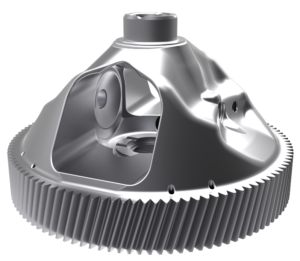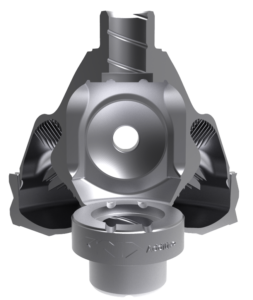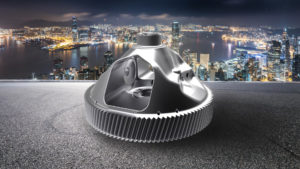 Steel, particularly stainless steel and tool steel, is a reliable and commonly used material in industries including tooling and biomedical. What is still relatively uncommon, however, is steel material for additive manufacturing. It exists, it’s just not as common as other metal materials – which is a shame as steel has a number of highly useful properties, such as high strength and corrosion resistance. A new steel material recently joined the additive manufacturing market, however, in the form of GKN Sinter Metals‘ 20MnCr5.
Steel, particularly stainless steel and tool steel, is a reliable and commonly used material in industries including tooling and biomedical. What is still relatively uncommon, however, is steel material for additive manufacturing. It exists, it’s just not as common as other metal materials – which is a shame as steel has a number of highly useful properties, such as high strength and corrosion resistance. A new steel material recently joined the additive manufacturing market, however, in the form of GKN Sinter Metals‘ 20MnCr5.
20MnCr5 is strong yet ductile, tough yet machineable, and boasts high fatigue strength and wear resistance. Porsche Engineering recently used the material to 3D print components for its e-drive powertrains, namely a conventional front transverse transmission. For optimum benefit, the part with the largest weight reduction potential, the differential housing with a ring gear, was chosen.
The ring gear and the differential housing serve different functions in a conventional transmission. The ring gear is made of specific steel, which is then hardened and ground for precision. The differential housing is usually casted and used for torque transfer from the ring gear to the center bolt and bevel gears. The wide ring gear teeth are supported by a thin, sometimes off-center, disc, which is connected to the differential housing. GKN and Porsche used CAD software and topology structural optimization to design a new shape based on the forces. The maximum available space within the transmission was then defined. All of the inner contours needed for any function, such as bevel gears, side shafts and bearings were subtracted from the body.
Based on the specifications and requirements of the transmission, all loads, including bearing and gear, were applied to the package block. The CAD optimization tool created a structure capable of taking all required loads. The resulting structure cannot be manufactured by any other means than additive manufacturing.
The inner shape is supported only by a system of organic beams and structures necessary for its structural integrity. These shapes cannot be machined by conventional methods. The structure also requires special features like holes to eject the unused metal powder after manufacturing, and openings on the outer diameter so that collected oil can drain in the inner area of the differential. These features can all be planned in the CAD model.
The final finite element analysis showed a homogenous stress level and allowed wall thickness to decrease, which is not possible with other manufacturing methods due to machine limits. Based on original load requirements, the team was able to decrease weight by 13%, or about one kilogram; they also achieved 43% decrease of tooth stiffness variations in radial direction, 69% decrease of tooth stiffness variations in tangential direction, and 8% reduction of inertia.
Automobile manufacturers are constantly looking for ways to improve vehicle efficiency, whether it’s reducing weight, creating more efficient internal combustion engines, or improving powertrains. More and more of these manufacturers are turning to additive manufacturing to prototype and even manufacture parts, many of them with geometries impossible to achieve with traditional manufacturing. Add that to the materials that additive manufacturing offers, such as GKN’s 20MnCr5, and manufacturers are capable of creating complex, lightweight parts that withstand high wear.
GKN has been exploring the benefits of automotive additive manufacturing, and this recent application highlights several key capabilities of 3D printing. Read the full case study at the GKN Sinter Metals blog.
Discuss this and other 3D printing topics at 3DPrintBoard.com or share your thoughts below.
[Images provided by GKN Sinter Metals]
Subscribe to Our Email Newsletter
Stay up-to-date on all the latest news from the 3D printing industry and receive information and offers from third party vendors.
You May Also Like
High Stakes, High Speed: KVG Acquires 15 Nexa3D HSE 3D Printers to Boost Military Tech
As 3D printing increasingly intersects with defense and military logistics, a new partnership between Nexa3D and mission support logistics firm KVG stresses the growing importance of this technology in strategic...
3D Printer Maker EVO-tech Reborn as NEVO3D — Once More With Feeling
EVO-tech was a 3D printing service and original equipment manufacturer established in 2013 and based in Schörfling am Attersee, Austria. The company produced high-quality material extrusion systems featuring linear bearings,...
3D Printing News Briefs, March 16, 2024: Partnerships, Affordable Bioprinter, & More
We’re starting with dental 3D printing news today, and then moving on to some new partnerships. Then it’s on to some interesting university research about 3D printing plant-based pharmaceuticals, but...
FDR vs. SLA: The Right Polymer Manufacturing Choice for Your Application
The additive manufacturing (AM) industry has no shortage of acronyms when it comes to the various methodologies of industrial 3D printing. In polymer 3D printing, there are three main methods...





































